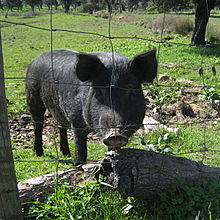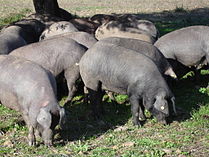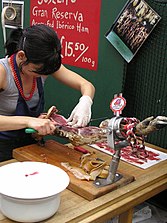Black Iberian pig
You can help expand this article with text translated from the corresponding article in Spanish. (November 2018) Click [show] for important translation instructions.
|
 | |
| Country of origin | Iberian Peninsula |
|---|---|
| Traits | |
| |


The Iberian pig, also known in Portugal as the Alentejo Pig, is a traditional breed of the domestic pig (Sus scrofa domesticus) that is native to the Iberian Peninsula. The Iberian pig, whose origins can probably be traced back to the Neolithic, when animal domestication started, is currently found in herds clustered in Spain and the central and southern part of Portugal.
The most commonly accepted theory is that the pigs were first brought to the Iberian Peninsula by the Phoenicians from the Eastern Mediterranean coast (current-day Lebanon), where they interbred with wild boars.[citation needed] This cross gave rise to the ancestors of what are today Iberian pigs. The production of Iberian pig is deeply rooted to the Mediterranean ecosystem. It is a rare example in world swine production where the pig contributes so decisively to the preservation of the ecosystem. The Iberian breed is currently one of the few examples of a domesticated breed which has adapted to a pastoral setting where the land is particularly rich in natural resources, in this case acorns from the holm oak, gall oak and cork oak.[1]
The numbers of the Iberian breed have been drastically reduced since 1960 due to several factors such as the outbreak of African swine fever and the lowered value of animal fats. In the past few years, however, the production of pigs of the Iberian type has increased to satisfy a renewed demand for top-quality meat and cured products. At the same time, breed specialisation has led to the disappearance of some ancestral varieties.[2]
This traditional breed exhibits a good appetite and propensity to obesity, including a great capacity to accumulate intramuscular and epidermal fat. The high intramuscular fat is what produces the typical marbling; this, together with traditional feeding based on acorns, is what makes its ham taste so special. Iberian pigs are interesting from a human biomedical perspective because they present high feed intake and propensity to obesity, compatible with high values of serum leptin.[3]
The Iberian pig can be either red or dark in colour, if black ranging from dark to grey, with little or no hair and a lean body, thus giving rise to the familiar name pata negra, or "black hoof". In traditional management, animals ranged freely in sparse oak forest (dehesa in Spain, montado in Portugal), they are constantly moving around and therefore burn more calories than confined pigs. This, in turn, produces the fine bones typical of this kind of jamón ibérico.

At least a hectare of healthy dehesa is needed to raise a single pig, and since the trees may be several hundred years old, the prospects for reforesting lost dehesa are slim at best. True dehesa is a richly diverse habitat with four different types of oak that are crucial in the production of prime-quality ham. The bulk of the acorn harvest comes from the holm oak (Quercus rotundifolia) from November to February, but the season would be too short without the earlier harvests of Pyrenean oak (Quercus pyrenaica) and Portuguese or gall oak (Quercus lusitanica), and the late cork oak (Quercus suber) season, which between them extend the acorn-production period from September almost to April.[4][5]
See also
References
- ^ Lopez-Bote, C J Sustained utilization of the Iberian pig breed Available online 18 October 2003; Departamento de Producción Animal, Facultad de Veterinaria, Universidad Complutense, Madrid, Spain
- ^ E Fabuel, E; Barragán, C; Silió, L; Rodríguez, L C and Toro, M A Analysis of genetic diversity and conservation priorities in Iberian pigs based on microsatellite markers Heredity (2004) 93, 104–113, advance online publication 19 May 2004
- ^ Fernandez-Figares I et al 2007: Serum profile of metabolites and hormones in obese (Iberian) and lean (Landrace) growing gilts fed balanced or lysine deficient diets. Livest Sci, 110:73-81.
- ^ Eveleigh, Mark Free little pigs Archived May 21, 2008, at the Wayback Machine December 2007
- ^ Harris, Don The Wild West of Spain Archived 2008-03-22 at the Wayback Machine October 2005
